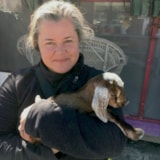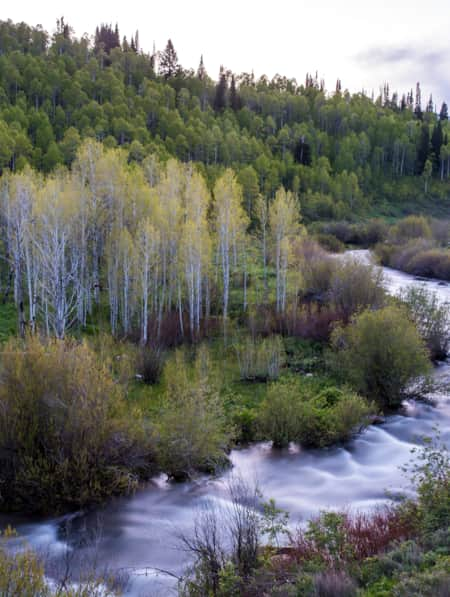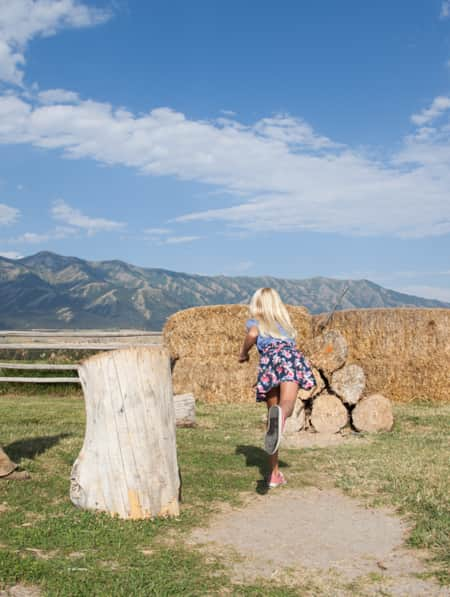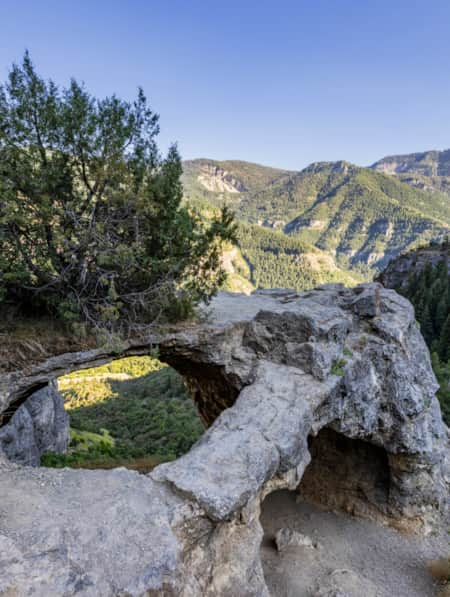Slide Ridge Finds the Sweet Spot in Their Honey Business
Even in the Beehive State, ingenuity is required to raise honeybees and support a thriving honey business.

The most crucial time of year for honeybees and their keepers is fast approaching as I’m talking with Martin James. It’s late February and he’s got me on speakerphone while he’s driving between inspections of his honeybee hives installed in California almond groves, explaining the bees' job now is to pollinate the trees from early February through mid-March.
In a few weeks, James will be loading his hives back onto semi-trucks for their return to Slide Ridge’s homebase in the small agricultural community of Mendon, near Utah’s northern border with Idaho. (Read: "Utah Food Trails" for a honey-based tour through the beehive state.)
“Then they start the spring buildup,” he explains of the importance of the annual hive expansion in March, which is directly dependent upon the temperatures climbing and bees finding enough pollen to support the brood they are trying to raise. “This is the crucial time for raising a lot of baby bees,” he says of March and April. “This will make or break your year.”
James’ love for all things bee-related started as a child, when he convinced his parents that he wanted to start keeping bees on the family property in Cache Valley. At the age of nine, he asked to take a summer class through the nearby Utah State University’s agricultural extension office. The instructor agreed that young Martin could attend, but only as long as his mother would also be there to sit next to him the entire class.
Now a parent himself, James acknowledges that his parents were incredibly accommodating. “I really appreciate the lengths my parents went to,” in giving him access to specialized education at a young age. His father, a mechanical engineer, even helped him build his first hives.
Sadly, when he established his initial three hives, that season ended in tragedy. A large agribusiness moved near the James family farm and dusted the business’s row crops with pesticides. This wiped out all the James’ bees. Devastated by this experience, Martin James hung up his kid-sized bee suit.
But his love of being able to work outside in nature stuck with James, and about two decades later he decided to get back into beekeeping as a full-time business with the help of his extended family.


Tracking the health of each beehive is a crucial, ongoing part of beekeeping, as is monitoring the vitality of each hive’s queen and community.
The Start of Slide Ridge
In 2004, Martin James founded Slide Ridge after being mentored by several big names in the beekeeping business. Like so many other agricultural jobs, it’s tough to break into beekeeping if you’re not born into it, he explained. “It’s hard to get over the hump of building up production and supply,” he says of starting beekeeping at an economy of scale to make it profitable.
His first year in business was a complete shock. “The amount of money I made [selling honey to a broker] versus the amount of time and care and hard work that goes into making good honey didn’t add up.”
To make a profit, it quickly became evident to James that he would need to increase the sheer number of hives he tended, and would also need to diversify the company’s business model to include more than just selling honey. Capitalizing on Slide Ridge honey’s pure, clean flavors and distinctive whiskey hue, James saw an opportunity to market it as an artisan product.
And that didn’t just stop with bottling honey. “I was able to do it,” says James of the transition to a multi-faceted business model based upon sustainable production. “It took a few miracles.”
In addition to selling honey, Slide Ridge also offers artisanal honey vinegars highly coveted by chefs and canny vinegar connoisseurs. The company also makes an award-winning apple-honey wine, while offering a bee nutrition and beekeeping education program. They also breed bees and queens for other beekeepers to purchase.
On top of all that, the company outsources pollination contracts for California almond groves, like the ones he was checking in on when I called him in February. “It makes for a well-rounded business model,” James says. “It’s all interconnected.”

Slide Ridge's honey boasts pure, clean flavors and a distinctive whiskey hue.


The Many Facets of Slide Ridge’s Honey Farm
“The keeping of bees is like the direction of sunbeams,” wrote Henry David Thoreau of its bucolic nature. While this may hold true for hobby beekeeping, the actual day-to-day keeping of bees on any scale appears to me, as an observer, to be incredibly stressful. There are a few known paths to keep bees healthy and happy, but it seems like there are a multitude of ways that it can quickly and irrevocably go sideways, as Martin James sadly discovered as a child.
Tracking the health of each hive to check for parasites and disease is a crucial, ongoing part of beekeeping, as is monitoring the vitality of each hive’s queen and community. And winter bee die-offs are one of the biggest threats to healthy hives, with cold temps and lack of winter forage having a loss rate of around 15 percent, even in relatively stable conditions. Since the early 2000s, researchers have noted honeybee loss rates overall have almost doubled due to a difficult-to-control combination of pests, disease, environmental stress and pesticide exposure.
“Opening a box full of dead bees is the saddest thing,” says Kelli Bess, Slide Ridge’s marketing and communications director, and James’s sister. “It’s just heartbreaking.”
Along with another of the James siblings, fellow beekeeper (and Slide Ridge’s accounts manager) Karla Bingham, Martin James began looking into ways to boost bee health at crucial points in the hive’s development. To prevent die-off due to temperature shock, at fall’s first frost James and Bingham move the hives into a climate-controlled barn, where the bees stay at a stable 50-ish degrees Fahrenheit and are acclimated prior to their move to California each January.
In addition to temperature control, James says, “Ninety-nine percent of what you do as a [successful] beekeeper is what you do with the health and nutrition of honeybees.” This attention is especially crucial during the spring build up of the hive, when baby bees often need a big boost of protein and carbohydrates. “And just like humans,” Bess explained to me, “if your nutrition and gut health is off, it affects your health overall.”
She added that Martin figured out which probiotics were most helpful for bee health, and developed nutrition supplements that boost the immune system of bees, especially in early spring if they can’t find the pollen they need available when foraging in nature. Slide Ridge sells their bee nutrition and probiotic products directly to consumers, and through agriculture supply stores such as IFA.
Sharing his knowledge about bee health and beekeeping success is a passion for James. He serves as a regional hive inspector, teaches classes about beekeeping and mentors newbie apiarists. On the company’s website, Slide Ridge posts videos about bee nutrition, the meticulous care of queens and identifying and treating mites and diseases.
Pollinators, Production and Stocking the Pantry
So reliant are almond trees on honeybees for pollination that beekeepers from all over the country converge upon California’s groves in semi-trailers filled with beehives in January and February. For many beekeepers, this is their budgetary bread and butter, James says, adding that his company only makes about 8 percent of its profit from honey sales. In contrast, about 90 percent of the company’s profit comes from pollination contracts.
James is highly selective about which almond groves he’s willing to contract with to ensure the health and safety of his bees, along with the hives’ security. Hives are frequently stolen for lucrative resale.
When James returns to Utah with his hives in March, they’re placed throughout the greater Cache Valley. This area is the cradle of much of the state’s agricultural bounty of fruit orchards, vegetable farms and fields of wildflowers. This marries well with beekeeping, while cultivating beneficial relationships with farmers whose crops thrive with bee pollination, Bess says.
“It’s a team thing,” she says, of placing their hives in local orchards that pledge not to use pesticides. “They’ve got apples, we’ve got bees. And we need a place to put them,” so it turns out to be a win-win agreement.
The work of extracting the distinctively clean, mellow honey from the beeswax comb — with machinery adapted and maintained by Martin James’s father, the mechanical engineer — happens at the Mendon warehouse. There, the honey is bottled under the Slide Ridge name, and as the store brand for local distributors like Associated Foods and Utah-owned Harmon’s Grocery. Much of the wax goes back onto the frames to encourage new bee comb development, and the remainder is sold as organic beeswax to companies, such as Burt’s Bees, or for craft goods like soap and candle making, closing this sustainability loop.
"Cache Valley is the cradle of much of the state’s agricultural bounty of fruit orchards, vegetable farms and fields of wildflowers. This marries well with beekeeping."

James also identified an untapped niche in producing a line of artisanal honey vinegars from reading vintage books. “I love old textbooks,” he says of this ah-ha moment. Specifically, in Dr. C. C. Miller’s “Fifty Years Among the Bees,” published in 1903, he learned that people used to eat raspberries pickled in honey vinegar.
This was a preservation method used to preserve fruit before refrigeration. James took a deep dive into what would go into making honey vinegars the old-fashioned way, which means that he would need to make mead (fermented honey wine) to convert into vinegar.
“A lot of the honey vinegar on the market is just distilled vinegar that they’ve added honey to, and it burns your mouth,” Bess shares. “True honey vinegars are mellow and nuanced, rather than pungent.” You can tell the difference immediately, she adds. The beekeepers were hooked after trying a true honey vinegar from Italy, and another one made in Washington state.
“The key to making good vinegar, is it that has to be made from good wine,” James says. As any kind of alcohol production is highly regulated in the United States, Slide Ridge became a Utah-licensed winemaker, and then began making mead and wine replicating ancient Viking cyser recipes. (Cyser is mead made from apples.)
Their Slide Ridge CaCysir — that name a combination of “Cache” and “cyser” — is an award-winner in the dessert wine category, with the 13.6 percent alcohol by volume apple-honey wine described as “aromas of baked apple and honeyed tangerine zest with pleasant undertones of clove, allspice, and cinnamon.”
“People cried alligator tears rolling down their cheeks, it’s so good,” James says of that initial award. In addition to sipping this delicious elixir as a dessert wine, James recommends serving it over ice with a splash of seltzer, a com bination that I whole-heartedly attest is a truly refreshing spritzer on a hot summer day.
You might even find some of the James family enjoying one at lunchtime after an especially busy week. After all, the family matriarch, Jean James, still makes lunch for the family and extended Slide Ridge work crew every day. “Even the UPS driver and the Fed Ex guy know to stop in,” James says. “Mom insists that everyone come in, no matter what they’re doing, and have lunch.”
The lunch table includes a place for visiting photographers, and always-up-for-it freelance food writers like myself. I happen to be grateful to get another taste of that distinctive Slide Ridge honey in whatever delicious form it might take.

In addition to selling honey, Slide Ridge also offers artisanal honey vinegars highly coveted by chefs and canny vinegar connoisseurs.
Photo: Austen Diamond
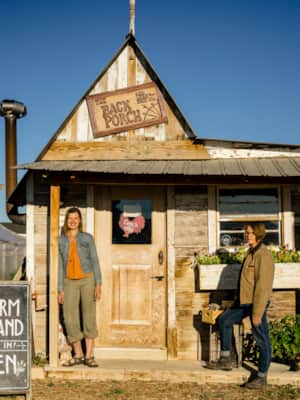
Good Roots: The Faces of Utah’s Food Culture
Meet some of the agricultural entrepreneurs that are elevating the tastes of Utahns and visitors through heritage and best practices, new and old.
What's Nearby
-
Bear Lake State Park
Bear Lake is a 20-mile long and eight-mile wide natural lake with beautiful, placid waters that perfectly match the tranquil pace of the quaint towns that dot the shore. The northern half is located in Idaho and the southern half in Utah with the state lines dividing it.
-
Bear River Migratory Bird Refuge
This is the Bear River Migratory Bird Refuge, an eye-opening stop along Utah's populous Wasatch Front for any traveler and a top destination for any serious birder with gaps on their life lists.
-
Beaver Mountain Resort
Beaver Mountain Resort sits in the northeast corner of Utah with 828 acres of prime mountain terrain. This is a great ski resort near Logan, Utah and Idaho.
-
Cherry Peak
Cherry Peak is located just 15 miles from Logan, near the Idaho border. The family-owned, nearly 400-acre resort, features three triple chairlifts, a comprehensive snowmaking infrastructure and a 1.25 mile-long run.
-
Hyrum Lake State Park
Willow, box elder and maple trees surround Hyrum Reservoir providing shade as well as habitat for waterfowl and wildlife.
-
Uinta-Wasatch-Cache National Forest
The Uinta-Wasatch-Cache National Forest (UWCNF) encompasses Utah's Wasatch Mountains adjacent to the state's northern metropolitan area, and the north slope of the High Uintas Wilderness.
